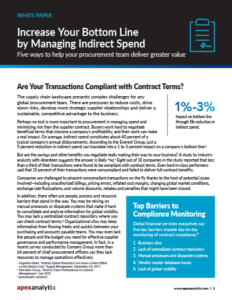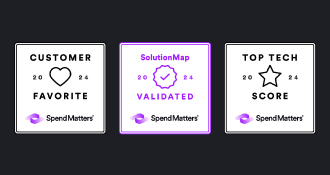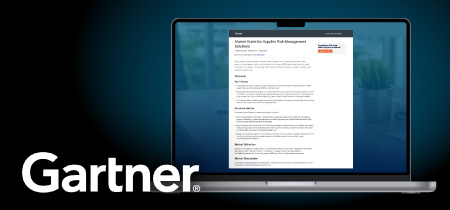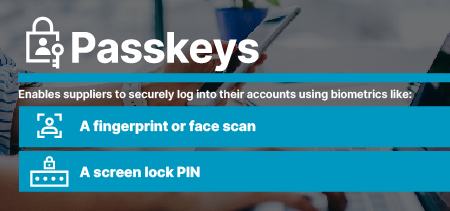
Are Your Transactions Compliant with Contract Terms?
The supply chain landscape presents complex challenges for any global procurement team. There are pressures to reduce costs, drive down risks, develop more strategic supplier relationships and deliver a sustainable, competitive advantage to the business.
Perhaps no tool is more important to procurement in managing spend and minimizing risk than the supplier contract. Buyers work hard to negotiate beneficial terms that improve a company’s profitability, and their work can make a real impact. On average, indirect spend constitutes about 40% of a typical company’s annual disbursements. According to the Everest Group, just a 5 percent reduction in indirect spend can translate into a 1 to 3 percent impact on a company’s bottom line.¹
Sign up to receive Analyst Reports, Webinars & more Procure-to-Pay Content
But are the savings and other benefits you negotiate really making their way to your business? A recent study by industry analysts with Aberdeen suggests the answer is likely “no.” Eight out of 10 companies in the study reported that less than a third of their transactions were found to be compliant with contract terms. Even best-in-class performers said that 15 percent of their transactions were noncompliant and failed to deliver full contract benefits.
Companies are challenged to pinpoint noncompliant transactions on the fly thanks to the host of potential issues involved—including unauthorized billings, pricing errors, inflated cost margins, changing global market conditions, exchange rate fluctuations, and volume discounts, rebates and penalties that might have been missed.
In addition, there often are people, process and resource barriers that stand in the way. You may be relying on manual processes or disparate systems that make it hard to consolidate and analyze information for global visibility. You may lack a centralized contract repository where you can check contract terms.² Organizational silos may keep information from flowing freely and quickly between your purchasing and accounts payable teams. You may even lack the people and the budget you need for effective supplier governance and performance management. In fact, in a recent survey conducted by Consero Group more than 64 percent of chief procurement officers say they lack resources to manage operations effectively.
Key Enablers to Optimize Your Indirect Spend
People, process and resource barriers can be overcome. Adopting the five best practices below can help you promote contract compliance, manage your suppliers more strategically and deliver greater bottom-line value to your business.
1. Use Automation to the Fullest
Use an automated technology ecosystem to support your procure-to-pay process workflows—maximizing your visibility into your suppliers, your disbursements and your internal operations. With the right technology tools, you will be poised to take a systems-wide approach by gathering, consolidating and analyzing data from all your procure-to-pay platforms companywide.
Automation can also help you uncover vital information on the contract side. Unless you have a centralized contract repository that is carefully maintained, relevant contract data can often be buried deep in email and other electronic documents. Data mining tools can be used to search for key words and to uncover negotiated terms that aren’t reflected in master documents.
2. Analyze and Measure
Use your technology ecosystem to measure and monitor your performance globally—including the percentage of indirect spend controlled via negotiated contracts, the number of purchase orders and more.
Common procurement KPIs include contract compliance, the return on investment you deliver, your procurement cycle time from sourcing to contract execution, supply quality and delivery timeliness, supplier “density” and the number of sole-sourced contracts which can represent a risk to inventory, service levels, etc. Also consider external metrics for indirect spend suppliers, including KPIs for customer satisfaction, cost competitiveness, innovation, cost reduction initiatives, commercial terms and contract compliance.
3. Standardize Policies and Controls
Establish, communicate and monitor contracting and procurement policies companywide. Policies should include, but are not limited to, competitive sourcing, internal delegation of authority guides, standard contract terms and audit rights, a code of ethics and conflict of interest guidelines. Institute controls to track the adherence to your policies throughout your supply chain.
When you support your standardized policies and controls with automation, you can view critical data as a consolidated whole, evaluate compliance and control “maverick” purchases made outside of procurement-negotiated contracts. You also will be able to develop new insights into additional controls and standards required.
4. Routinely Audit and Recover
To achieve visibility into many indirect spend issues that could be hidden from view, conduct contract compliance audits at regular intervals. You will be able to identify and recapture losses by validating supplier adherence to negotiated contract terms. Industry experience suggests that on average, 1 to 5 percent of spend can be recovered.
A contract compliance audit shouldn’t be confused with a traditional audit of accounts payable or supplier statements. It goes well beyond a reconciliation of accounts or the identification of duplicate payments. Instead it involves a comprehensive analysis of whether a supplier or group of suppliers is adhering to commercial contract terms negotiated by your buyers.
In addition to reining in your indirect spend through contract compliance audits, you can use your audit to identify process improvements that promote future compliance and prevent further savings leakage. One byproduct of a “deep dive” into your contracts and supplier relationships is to expose strategic opportunities, such as new business models, options for supply source consolidation or ways to build stronger contracts.
5. Establish Internal Partnerships
Historically, accounts payable and procurement have operated as separate business silos with different reporting structures, priorities and success measures. Best-in-class organizations, though, are leveraging synergies between the two functions to broaden spend management, improve contract compliance and optimize profitability.
When the gulf between procurement and payables is broad, it can be a challenge to bridge the gap. But the potential payoff makes it worth the extra effort. Look for ways to open the lines of communication and meet regularly to share insights. Build on those initial efforts by collaborating on special projects that can benefit both functions and add value to the broader business.
An expert at Ardent Partners³ says the ultimate goal is alignment of procure-to-pay processes and technologies to reflect the best insights of both procurement and accounts payable. Steps towards this goal lead to an even higher level of communication and collaboration, greater visibility, broader business intelligence and far better bottom-line results for both functions. Everybody wins, regardless of where they report.
How Does Your Procurement Function Measure Up?
Studies show that procurement organizations move through several distinct stages. The least mature are largely reactive to purchasing demands, with few policies to guide or govern their activity. Optimized organizations are proactive and focused on total cost of ownership, sourcing and demand management. But the most mature organizations of all go a step further. They look at procurement as a way to add true sustainable strategic value and to help their company achieve a competitive advantage.4
To move your organization along the maturity continuum, break down internal silos and focus on optimal procure-to-pay systems, policies and procedures. Adopt automation and use KPIs to drive continuous improvements that impact your organization’s bottom-line. Keep your indirect spend in check through proactive governance and effective relationships with suppliers. Most importantly, conduct regular compliance audits. Measuring supplier behavior and performance can lead to significant cost recoveries and help you uncover opportunities for future negotiated savings.
To Find Out More
If you would like to know more about best practices-based software that can reduce your risk of duplicate payments, contact apexanalytix at +1 800-284-4522.
About the Author
Pete Erdner is the Vice President of Commercial Operations at apexanalytix and is responsible for the oversight, management, profitability and renewal of commercial audit engagements as well as adding value for clients in the form of recovered monies and enhanced internal controls. He is also instrumental in keeping commercial operations at the leading edge of the industry by driving the use of new technologies such as predictive analytics and robotics. Pete has been in Operations at apexanalytix for more than 18 years. Prior to joining apexanalytix, Pete’s career experience included public accounting, tax preparation and auditing. Pete holds a BA in Corporate Communications with a Business Administration minor from Elon University. Pete is also a Certified Public Accountant and a member of the AICPA, NCACPA, IIA and IAPP.
¹ Angeline Albert, “Indirect Spend Reduction Can Have a Direct Effect on the Bottom Line,” Supply Management, September 23, 2011.
² Aberdeen Group, “Best-in-Class Performance in Contract Management,” July 2015.
³ CPO Rising, “Accounts Payable and Procurement Collaboration: Two Hearts Beat as One,” July 8, 2014.
4 Bain & Company, “Winning with Procurement in Asia,” www.bain.com, December 11, 2013.







